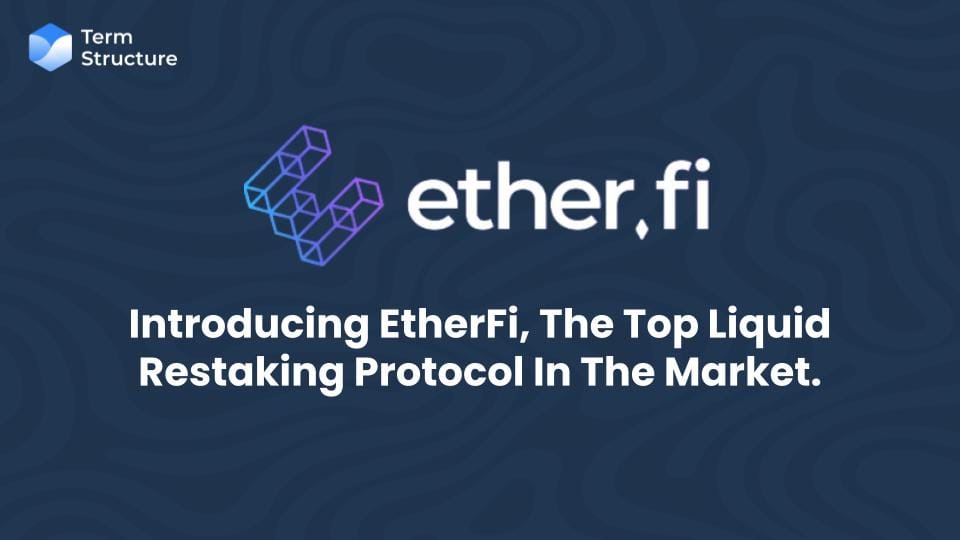Introducing EtherFi-The Top Liquid Restaking Protocol In The Market.

Whether in a bull market or not, the crypto space has always been buzzing with new releases and announcements. One notable development in the crypto space is restaking, powered by EigenLayer. This innovation has led to the emergence of a new sector called liquid restaking, which has attracted significant interest from crypto enthusiasts due to its promising yield prospects. Among the various protocols in this sector, EtherFi has emerged as the largest and most popular choice. So, what is EtherFi, and what makes it stand out from the rest? In this article, we will explain how restaking addresses the downsides of staking, how EtherFi works, its potential, and future development.
What Is ETH Liquid Restaking?
Before diving into liquid restaking, let’s discuss what staking is. Staking in involves locking up crypto in a blockchain network to support its operations, such as validating transactions, in exchange for rewards. It is a key component of Proof of Stake (PoS) networks to help them improve their security and decentralization. However, one downside to traditional staking is that assets are locked up and inaccessible. Restaking addresses this by enabling token holders to gain liquidity from their assets while still earning potential rewards. This makes staking more attractive for those seeking both liquidity and flexibility.
What is Etherfi?
EtherFi is a decentralized, non-custodial, liquid restaking protocol on Ethereum. Its unique feature is that it provides users with returns on their ETH while ensuring they retain full control of their keys. This setup allows EtherFi users to reclaim their ETH in case of potential security threats or issues with the node operator, offering added security and peace of mind.
EtherFi works with EigenLayer to incorporate its native restaking functionality. This integration enables EtherFi users to earn additional rewards beyond Ethereum staking returns, and it allows them to participate in restaking without locking up their assets. EtherFi users receive LST tokens in the form of eETH when they stake their ETH. These eETH tokens can be used across various DeFi protocols on Ethereum.
EtherFi introduces T-NFT and B-NFT tokens, which offer incentives and flexibility to stakers and node operators. Through these various incentives and rewards, EtherFi presents itself as a viable choice for crypto enthusiasts seeking to generate interest on their assets.
How EtherFi Works
EtherFi offers users a secure way to stake Ethereum through its Operation Solo Staker, which uses a non-custodial approach. This operation allows individuals to run nodes via two different paths.
First, there is the Distributed Validator Technology (DVT) path, where users can operate permissionless nodes by distributing validator keys among multiple node operators. This enhances network decentralization and minimizes risks. To participate, you need hardware and a minimum collateral of 2 ETH, while EtherFi provides technical assistance and the remaining 30 ETH.
The second path, Operation Solo Staker, does not require users to supply any ETH as collateral. EtherFi provides the full 32 ETH. Stakers only need to configure the hardware, undergo KYC procedures, and commit to serving as nodes for 2 years. Moreover, EtherFi is introducing an auction system to allocate staking opportunities for operators to enhance fairness and transparency for all network participants. With this understanding, let’s explore the key features of EtherFi.
Automatic Restaking (AR)
EtherFi features Automatic Restaking (AR), which significantly increases the earning potential from staked ETH by automatically restaking it. Unlike other protocols that depend on EigenLayer to raise caps before depositing users' tokens, EtherFi's native restaking on EigenLayer eliminates the need for such caps. This integration effectively allows users to validate different software modules outside the Ethereum network, maximizing their earnings and EigenLayer points. As a result, EtherFi ranks first in total value locked (TVL) within the liquid restaking sector.
Liquid
Liquid is an automated DeFi vault that enables users to earn extra returns on their eETH by investing in the DeFi ecosystem. Users can participate by depositing eETH, weETH, or WETH, and the vault distributes these funds across various DeFi positions.
The strategy, developed by Seven Seas, leverages their expertise in DeFi vault construction. Their vaults have facilitated over $10 billion in LST DEX volume and manage $600 million in LST through leveraged staking, earning direct incentives from various prominent DeFi projects. As the eETH ecosystem evolves, the vault will expand with new integrations, incorporating more protocols and use cases to remain competitive.
T-NFT and B-NFT
Remember the Bored Ape Yacht Club, once the most trending and valuable NFT? It might not be as prominent now, but NFTs have found their utility in DeFi. EtherFi's staking method uses two types of NFTs: T-NFTs (transferable non-fungible tokens) and B-NFTs (bound non-fungible tokens). When a new validator node is added, stakers receive both types of NFTs. The T-NFT can be transferred, while the B-NFT cannot be transferred. These NFTs serve as proof of ownership of the staked ETH and play a crucial role in safeguarding validator keys.
Etherfi’s Advantage.
After explaining how EtherFi works, let’s discuss the advantages of this protocol and how its native tokens could impact the restaking landscape.
- Non-Custodial: EtherFi is the only non-custodial Ethereum staking platform. This ensures that users have full control over their keys and minimizes the risk of attacks or issues with operator nodes.
- Profitable Returns: Users can earn additional returns through integration with EigenLayer to benefit from both ETH staking and native EigenLayer restaking.
- Robust Ethereum DeFi Integration: The eETH obtained through EtherFi staking can be used on multiple DeFi platforms within the Ethereum ecosystem. Additionally, EtherFi's Liquid feature can further enhance user returns.
EtherFi Token: ETHFI
ETHFI is the native token of the EtherFi ecosystem, introduced during a Token Generation Event (TGE) on March 18, 2023. ETHFI serves as the governance token on the EtherFi platform, allowing holders to oversee the use of EtherFi's reserve funds, modify the functionality of the ETHFI token, and establish platform policies.
With a total supply of 1 billion tokens, only 115 million ETHFI tokens are currently in circulation. The price of ETHFI has been on a downward trend, starting at $4.40 and currently at $3.51, marking a 24-hour decrease of -4.23%. The highest price ETHFI reached was $8.53.
ETHFI Token Potential
According to Defi Llama, the Total Value Locked (TVL) in restaking is $12.08 billion, making it the fifth largest in the market, with EigenLayer holding a substantial share of $12.03 billion. Notably, the liquid restaking sector has secured the sixth spot, outperforming established sectors such as yield, RWAs, and farming. As a major player in the liquid restaking sector, EtherFi stands to benefit from the immense popularity of this trend.
However, there are concerns about the sustainability of this sector due to its heavy reliance on EigenLayer. Vitalik has raised concerns that outsourcing security to EigenLayer could lead to systemic issues. For instance, if a significant number of validators securing the same network are compromised, it could create a cascading effect, impacting both EigenLayer and Ethereum as a whole. Moreover, EtherFi will need to continue establishing partnerships with more DeFi protocols to ensure eETH can be integrated and used as collateral across these platforms.
Partnerships
EtherFi works with some of the smartest people in Crypto. Notable projects include FINOA, NODERUN, COSMOSTATION, Obol, DSRV, dappnode, Chainnodes etc.
There is an opportunity for mutual benefit for projects looking to partner with etherFi, lending and borrowing platforms such as Term Structure can leverage eETH as collateral providing a win-win situation for the EtherFi and Term Structure communities.
Conclusion
In summary, the restaking sector, led by protocols like EtherFi, shows significant potential and innovation. EtherFi, with its non-custodial approach, Automatic Restaking (AR), and integration with EigenLayer, offers users enhanced security, and profitable returns. However, the sector faces sustainability challenges due to its heavy reliance on EigenLayer. Concerns raised by Vitalik about the risks of outsourcing security to EigenLayer highlight the need for caution and continued vigilance. Despite these challenges, the platform's integration within the Ethereum DeFi ecosystem and its continuous development make it a promising contender in the evolving landscape of DeFi.

